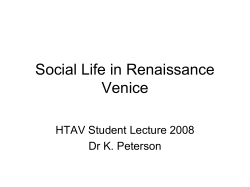
PORT OF VENICE How to Promote sustainable transport in the context of
PORT OF VENICE How to Promote sustainable transport in the context of climate change: the case of port of Venice Paolo COSTA, President PORT OF VENICE “How to Promote sustainable transport in the context of climate change “ • Sustainable transport can be promoted with a two layers strategy: ‐ “Greening "the whole logistic chain developing new transport multimodal routes with less impact on CO2 emission to achieve the environmental goals in the white paper on transport – F.I. the Baltic Adriatic Axis ‐ “Greening” maritime transport & port activities , entailing both cutting the GHG emissions and adaptation strategies – F.i. Port activities, environmental protection of the Lagoon and Heritage safeguard in Venice PORT OF VENICE Greening Logistic Chain: coping with Commercial Flows And Maritime Transportation TRANS-ATLANTIC Est.2009 size5.2 m TEU ASIA-EUROPE Est.2009 size16.0 m TEU TRANS-PACIFIC Est.2009 size17.3 m TEU INTRA-ASIA Est.2009 size56.2 m TEU LATIN-AMERICA Est.2009 size11.9 m TEU Source: Neptune Orient Lines (2009) CONTAINER TRAFFIC VIA SUEZ CANAL, 2000-2008 (MLN/TEU) Source: Suez Canal Authority; Drewry Shipping Consultants PORT OF VENICE 3 Greening the Logistic chain: serving European markets from Asia through the Mediterranean and its main gateways PORT OF VENICE 4 Greening the logistic chain: lowering the emissions Shipping a container, transported by ship and railway, from Suez to Prague via VENICE, rather than via HAMBOURG, allows for a reduction of 124 kg/Teu of CO2 emissions Emissions estimate on Suez-all Europe routes and railway transportation PORT OF VENICE Emissions estimate on Suez-Venice route and railway transportation 5 Greening the logistic chain: Focus on the Baltic Adriatic • Connecting Baltic and Adriatic ports •Shifting part of the Baltic Asian and Mediterranean Trade flows which are passing through Northern Sea Ports reducing CO2 Emission Things to be done: •Improving railway infrastructure and multimodal terminals to enable a quick and fast forward of the products •Increasing the handling capacity and last mile connections of NAPA ports PORT OF VENICE Greening maritime transport & port activities PORT OF VENICE 7 Greening Port Activities: Port of Venice main Environmental and Climate Change Issue Unique ecosystem, to be preserved by : – – – – – Port and City Sustainability Actions: Soil contamination Water contamination, wastewater Exhaust gas emissions Waste production Sediment contamination – – Interface city and port – Noise Dust (PM) Ships waves – – – – PORT OF VENICE 8 Preserving water and improving sediment quality Respect air quality standard Heritage conservation Energy Efficiency Port of Venice main Environmental and Climate Change Issue : main initiatives 1) MOSE Dams system & dredging channels for the protection of Venice Lagoon from High Waters / rising level of the sea 2) Reduction of CO2 and others GHG emissions: – Evaluation of biomass for energy and heat in port Area (Algae plant). – Design a photovoltaic park using port roofs and lagoon Island – “Cold Ironing” for the Use of energy on shore 3) Mitigation & other measures PORT OF VENICE The MOSE System to protect Venice and the Lagoon from High Waters & coping with port activities PORT OF VENICE Marghera freight port Passenger Terminal Port Inlets Protecting Venice lagoon from high waters Eviction of Oils from the lagoon & container offshore terminal The proposal contained in Law 798 dd. 29/11/84 is now extended to all types of goods. The terminal will be designed for oil traffic to be expelled from the lagoon (ex Article 3 of the above Law), not using anymore San Leonardo for oil traffic purposes. Oil: eviction from the lagoon and connection to the refineries in Marghera and Mantua (3 million tons/year in Mantua, 4 million in Marghera) Container: from 1.500.000 to 3.000.000 per year, of which 500.000 for Po River transport through Chioggia and Porto Levante New Offshore terminal PORT OF VENICE 11 The new offshore container and oil terminal PORTO MARGHERA VENICE LIDO SAN LEONARDO 8n aut ica lm 14. iles 8k m The Offshore Terminal is designed to allow, inside the breakwater, a modular construction of facilities dedicated to port operations, both in relation to the PORT OF VENICE types of goods to be moved and to the vessels to be accommodated. OFFSHORE 12 Greening Port Activities: Energy Saving Investments On going actions PORT OF VENICE Planned actions Greening Port Activities: the cold ironing technology for the energy consumption Main incoming substation RES Power cables Shore-side substation Berth terminal Onboard installation PORT OF VENICE 14 Microalgae Power Plant POWER PLANT FEATURES: * Location: Tresse Island * Facility Surface: 20 He (TBE) * NominalPower: 40-50 MW * Expected Cost: 200.000.000 Euros * Construction Time 2 years TECHNOLOGY (BFS) * Bio Fuel System * Microalgae: Diatomee * 2 Units: - Breeding PhotoBio Reactors - Conversion Unit * 80% Biomass for Bio fuels Production * 20% High Value Added substances ADVANTAGES: * Zero emissions * In Situ production * Maximize space and efficiency PORT OF VENICE 15 Greening Port Activities: Pilot Plant Venice Port • • • • Lab and research unit for project and managment of large project in Port of Venice Bioreactor have to be tested in local condition for discovering potential and weaks point for the Venice Lagoon Lab and research unit will develop byside product innovative extraction processes 0,5 Mw generating plant in Pellestrina Island PORT OF VENICE Mitigation Actions of dredging the lagoon and canals: the “Moranzani Agreement” – – – – – – Action is focused on hazardous and not hazardous contaminated sediment dredging: 1.65 M m3 removal from the port and industrial channel Navigation dredging coincides with Environmental Dredging This action is part of a wider project that will take the total requalification of sub urban area close to industrial port facilities. Dredging will be combine with roadway and hydraulic improvement, energy plant grounding, park and relocation of oil tank area One third of the cost will cover environmental compensation (old landfill safe action, grounding power plants…). Action will reduce contaminant reservoirs: polluted sediments. Financial amount for VPA will be about 51 M€ on 260M€ funds available (Moranzani Cost 478 M€) PORT OF VENICE MORANZANI AGREEMENT - ACTIONS Confined Disposal Facility for not hazardous sediment PORT OF VENICE Treatment Plants and Final Disposal for hazardous sediment Greening port activities: other initiatives • Preserving water and improving sediment quality through works on the channels banks and rehabilitation of industrial polluted areas • Respect air quality standard through the “Venice Blu Flag” , that provides on sulphur reduction and engine rules during mooring in Venice Port • Heritage conservation from erosion generated by waves: ship waves measurement through stereometric investigation (Hydra system) to control the respect of the navigation protocol whithin Venice. PORT OF VENICE Thank for your attention! Contact details: apv.presidenza@port.venice.it PORT OF VENICE
© Copyright 2025


















